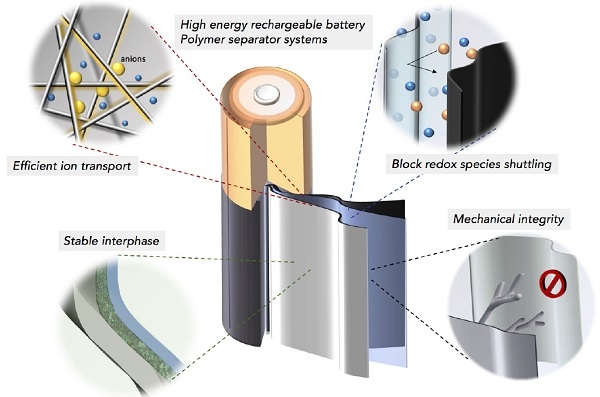Lithium battery separator is one of the key inner layer components of lithium battery. The performance of the separator determines the interface structure and internal resistance of the battery, which directly affects the capacity, cycle and safety performance of the battery. The separator with excellent performance plays an important role in improving the overall performance of the battery.

First, Characteristics of lithium battery separator
The main performance requirements of lithium-ion battery separators are: thickness uniformity, mechanical properties (including tensile strength and puncture resistance), air permeability, physical and chemical properties (including wettability, chemical stability, thermal stability, safety), etc. Four performance indicators.
Second, the performance of lithium battery separator
The lithium battery separator is located between the positive electrode and the negative electrode, and its main function is to separate the positive and negative active materials to prevent the two electrodes from short-circuiting due to contact; in addition, during the electrochemical reaction, it can maintain the necessary electrolyte and form a channel for ion movement. The diaphragm material is non-conductive, and the diaphragm used is different for different types of batteries. For lithium-ion batteries, since the electrolyte is an organic solvent system, the separator is required to have the following properties.
1. In the battery system, its chemical stability is better, and the materials used are resistant to organic solvents.
2. High mechanical strength and long service life.
3. The ionic conductivity of the organic electrolyte is lower than that of the aqueous system. In order to reduce the resistance, the electrode area must be as large as possible, so the diaphragm must be very thin.
4. When the battery system is abnormal, the temperature rises. In order to prevent danger, when the rapid heat generation temperature (120 ~ 140 ° C) begins, the thermoplastic diaphragm melts, the micropores are closed, and it becomes an insulator to prevent the electrolyte from passing through, thereby achieve the purpose of interrupting the current.
5. From the perspective of lithium batteries, it must be fully impregnated with organic electrolyte, and can maintain a high degree of impregnation during repeated charge and discharge.
Third, Classification of lithium battery separators
According to different physical and chemical properties, lithium battery separators can be divided into: woven film, non-woven film (non-woven fabric), microporous film, composite film, separator paper, rolled film and so on.
Polyolefin materials have excellent mechanical properties, chemical stability and relatively cheap characteristics, so polyolefin microporous membranes such as polyethylene and polypropylene have been used as lithium battery separators in the early stage of lithium battery research and development. Although in recent years there have been studies using other materials to prepare lithium battery separators, such as using polyvinylidene fluoride (PVDF) as bulk polymer to prepare lithium battery separators by phase inversion, and studying cellulose composite membranes as lithium battery separator materials.